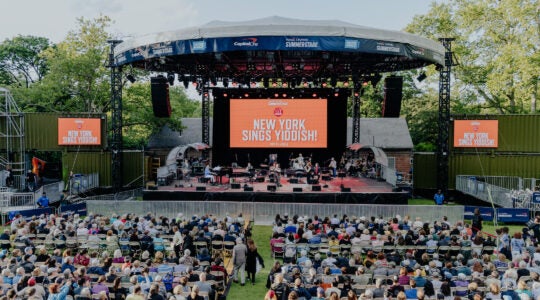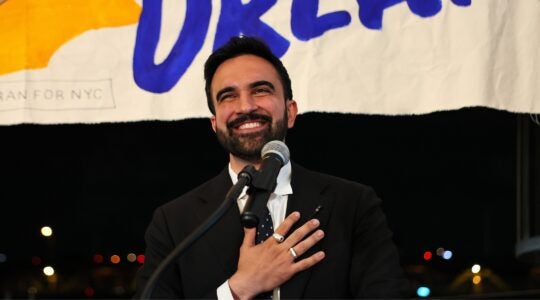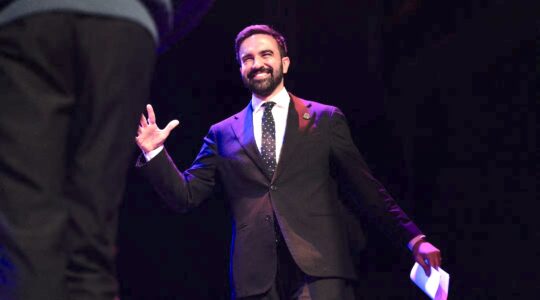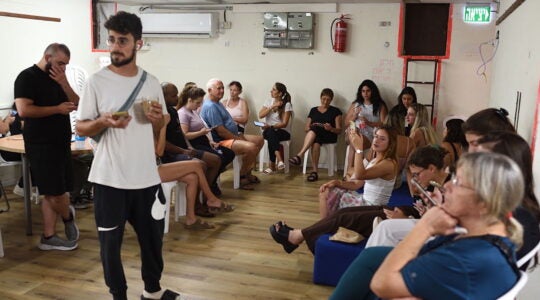The Jewish connection to the Olympic Games is as old as the modern Olympics movement. Unfortunately, some of the connections are tragic, like the murder of 11 members of Israel’s team at the Munich Games in 1972.
Last week The Jewish Week looked at some largely unknown parts of Olympic Jewish history. This week, the Olympics and the Holocaust.
According to lore, Ben Bril was the youngest boxer ever in the Olympics — he was 15 in Amsterdam in 1928. A 12-time Dutch champion, he boycotted the 1936 Summer Games in Berlin, the so-called Nazi Olympics. He and his wife were incarcerated at Bergen-Belsen during the Nazi occupation of the Netherlands; both survived. During a second career as a boxing referee, he worked at the Olympic matches of such fighters as Joe Frazier and George Foreman. Witnesses say he would enter the ring for a fight with his hair neatly combed, and “always came out the same way — untouched. For him, technique always came first.”
Sybil Cooper won seven gold medals in track and field during the first two Maccabiah Games in Palestine. How many Olympic medals she might have won in the Games for which she qualified is conjecture. Cooper, a world-class hurdler, joined a Jewish boycott of the ’36 Games in Berlin, and the 1940 event in Helsinki was canceled by fighting in Europe.
During her prime, Cooper defeated such outstanding athletes as Stella Walsh and Babe Didrickson. After her track career was over, she lived on the Lower East Side and worked as an artist in Greenwich Village.
Blond, blue-eyed Bernd Stevens qualified in 1935, at 16, as an alternate for the German Olympic ski team that would participate the next year in the Olympics. But Stevens was Jewish; he was off the team. After the Games, after Kristallnacht, his father and brother were taken to concentration camps. Stevens, with false papers, made his way to the United States. He joined the Army to “save whatever Jews could still be saved,” was recruited by the forerunner of the CIA, and became a parachutist. Later he became a CPA. Stevens entered competitive giant slalom events until he was 74.
The 1928 Netherlands women’s gymnastics squad that won medals for all-around team performance had a strong Jewish flavor — five members were Jewish. Four later died in the Holocaust. Stella Blits-Agsteribbe perished in Auschwitz. Three of her teammates lost their lives in Sobibor: Anna Dresden-Polak, Lea Kloot-Nordheim and Judikje Themans-Simons. In addition, the team’s coach, Gerritt Kleerekoper, was also murdered in Sobibor. Only one member of the team survived the Holocaust — Elka de Levie died in Amsterdam at 74.
Attila Petschauer, a Hungarian fencer, won three Olympic medals during the Summer Games of 1928 and 1932. During the Holocaust he was deported to a Nazi labor camp in Ukraine, where he was recognized by a Nazi officer who had been an equestrian competitor on Hungary’s ’28 Olympic team. The two had been friends, but in the camp, the officer ordered guards to taunt Petschauer.
“You, Olympic fencing medal winner … let’s see how you can climb trees,” the guards would yell. In midwinter, he was forced to climb a tree naked and crow like a rooster. The guards sprayed him with water. He died from exposure on Jan. 20, 1943.
Several other Jewish Olympians are known to have died in the Shoah. Among them are Alfred Flatow and his cousin Gustav Felix Flatow, German gymnasts; Ilja Szrajbman, a Polish swimmer; Janos Garay, Oskar Gerde and Endre Kabos, Hungarian fencers; Roman Kantor, a Polish fencer; and Otto Herschmann, an Austrian swimmer.
And one more victim, Dr. Ferenc Kemeny of Hungary, a supporter in 1896 of Pierre de Coubertin’s nascent Olympic movement, committed suicide with his wife during the Nazi occupation of his homeland rather than wear the yellow star.
By traditional Jewish standards, Helene Mayer was not Jewish — only her father was a Jew. But to the Nazis, she was Jewish enough for their public relations purposes. Mayer, a championship fencer who won an Olympic gold medal in 1928, stayed in the United States to study after taking part in the 1932 Summer Games in Los Angeles. Facing an American boycott of the ’36 Games in Berlin because of anti-Jewish discrimination, Germany invited — actually pressured — Mayer to join its national team. She did and won a silver medal in Berlin. Mayer moved back to the U.S. before World War II. As an American citizen she won the national foil championship eight times.
The German Olympic team at the 1936 Winter Games in Garmisch-Partenkirchen, Bavaria, already under Nazi aegis, was not entirely judenfrei — it had Rudi Ball. Ball, a star forward on Germany’s two-time world championship and 1932 Olympic bronze medal ice hockey team, was invited back from France, where he had gone on voluntary exile, to play on his homeland’s ’36 team. Ball, Germany’s best player, was injured during a game against Hungary and Germany finished fifth. After the war, he moved to South Africa.
1936 was the Nazis’ Olympic year.
Along with those Winter Games in Bavaria, the Summer Games were in Berlin. To fend off accusations of anti-Semitic persecution, the Germans removed some discriminatory signs from cities where reporters were sure to roam and allowed token Jewish representation on the otherwise Aryan squads. Nevertheless, there were calls to boycott the Games.
The Maccabi movement, which had held a winter competition in Poland in 1933, held its second Macabiah Winter Games in 1936 in Banska Bystrica, Czechoslovakia. The competition, billed in some circles as the First International Jewish Winter Olympics, was intended to serve as an alternative Games for Jewish athletes. Participants in the Czech event included hockey player Fritz Hirschberger, German-born son of a Christian mother and Jewish father, who settled in the U.S. and became a political organizer and artist.
Rain spoiled most of the competition, making the skating rink unusable, canceling the speed skating and figure skating events, and forcing the abandonment of the ice hockey tournament.
A wider-scale counter Summer Games were to be held in Spain, but the Spanish Civil War derailed that. In its place, a two-day World Labor Athletic Carnival was staged in August in the newly opened Municipal Stadium of Randall’s Island. Some 400 athletes, mostly from the U.S., took part in the competition sponsored by the Jewish Labor Committee.
Individual Jewish athletes faced the decision whether they should boycott the Berlin Games as a form of protest. Two outstanding sportsmen who stayed away from Berlin were Harvard track and field stars Milton Green and Norman Cahners, and Syd Koff (nee Sybil Tabachnikoff), a championship sprinter and jumper from the Lower East Side.
In the end, several Jewish men and women did compete at Berlin, intending their presence as a message against Nazi propaganda, and a dozen won medals.
Only two Jewish athletes, as far as is known, competed in the Olympics after surviving the Holocaust. They are Alfred Nakache, a French swimmer and water polo player, and Ben Helfgott, a British weightlifter. Nakache, the French 100-meter freestyle champion, was on his country’s squad in Berlin in 1936. Twelve years later, after Auschwitz, where his wife and daughter perished, he took part in London but did not win a medal.
Helfgott, the only member of his family who survived Buchenwald, moved to England after World War II. He captained the British weightlifting teams as Melbourne in 1956 and Rome in 1960. Helfgott was active in England assisting Holocaust survivors and chaired the Yad Vashem Committee of the Board of Deputies of British Jews.
The New York Jewish Week brings you the stories behind the headlines, keeping you connected to Jewish life in New York. Help sustain the reporting you trust by donating today.




